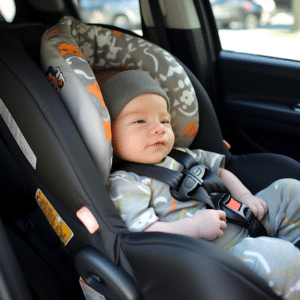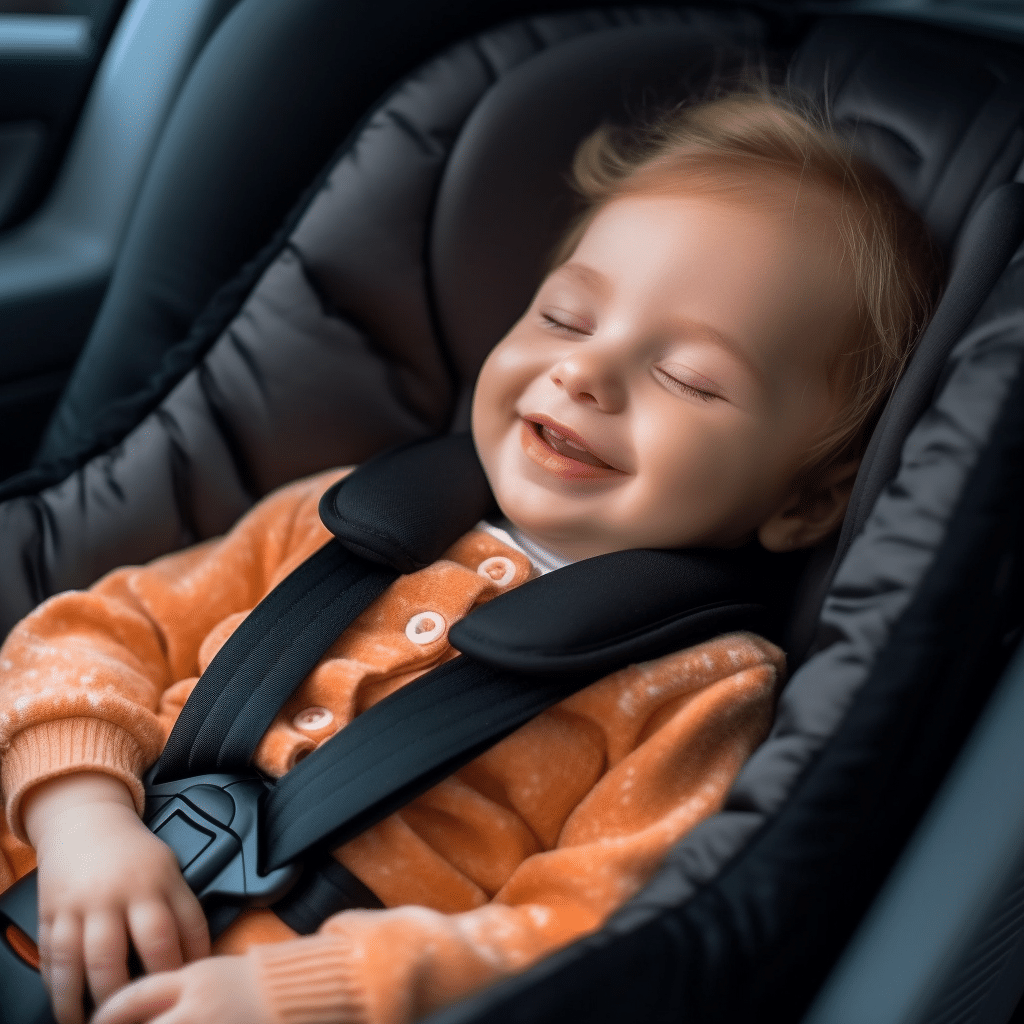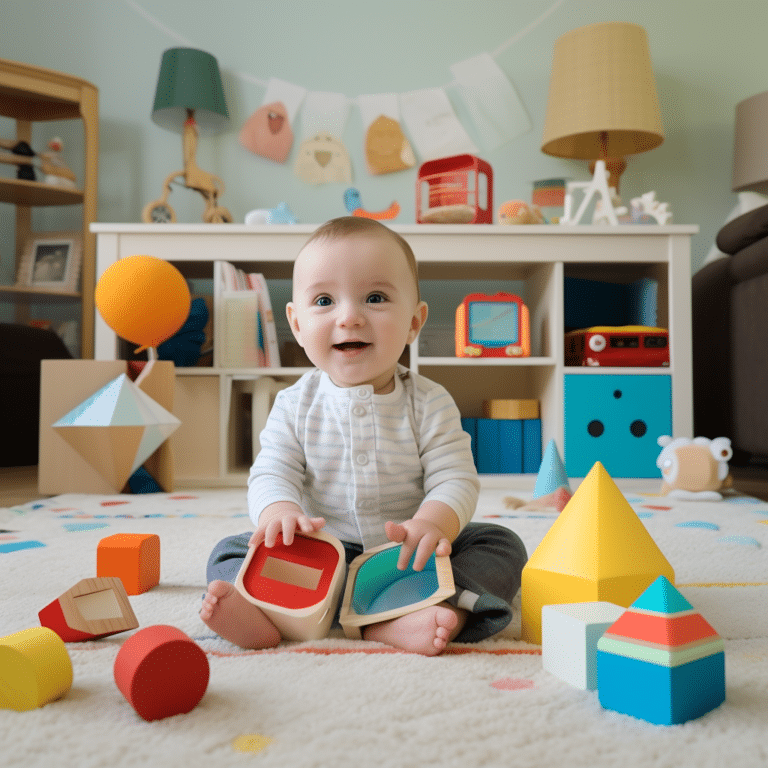Ensuring Newborn Car Seat Safety: Head Positioning
Importance of Properly Positioning a Newborn’s Head in a Car Seat
Newborn car seat head positioning head correctly in a car seat is vital. It keeps them safe, helps their airways stay open, and supports their neck and spine growth. If the head isn’t properly aligned, it can block airways, put pressure on their neck and spine, and make them uncomfortable while sleeping.
A friend of mine learned this lesson recently – her daughter’s head kept falling forward in the car seat. She stopped, adjusted the straps and padding, and the baby slept comfortably the rest of the trip.
Properly positioning your newborn’s head in a car seat is essential. It could even get you a parking spot at the busiest shopping mall during the holiday season!
Understanding the Risks of Incorrect Head Positioning

Incorrect head positioning can cause many issues; suffocation, respiratory problems, discomfort, and even injury. It’s essential for parents or caregivers to ensure proper head positioning in car seats. Using supportive cushions or devices, adjusting straps, and seat incline correctly are great ways to reduce any potential hazards.
It’s not just car seats, either – proper head support is vital for a baby’s safety and comfort during sleep, carrying, strollers, swings, and more.
A study conducted by The Journal of Pediatrics found 74% of infant vehicle-related deaths were caused by improper restraint use. Knowing the risks, and taking necessary precautions, is key in providing a safe environment that prioritizes your baby’s well-being.
Head support is essential for newborns’ comfort and security. So, strap it on and make sure your little one has a comfortable journey.
The Role of a Newborn’s Head Support in a Car Seat
Table:
| Column 1 | Column 2 |
|---|---|
| Safety | Positioning the head and neck to avoid injuries. |
| Comfort | Gives support to the delicate newborn head for a comfy ride. |
| Stability | Keeps the head steady during sudden movements or turns. |
| Protection | Guards the newborn from potential impacts in accidents. |
Besides its main job, the head support in a car seat also eases strain on the neck muscles and promotes healthy posture for the newborn.
Fun Fact: According to AAA (American Automobile Association), using the right car seat and adjusting it properly cuts infant fatality by 71%.
Positioning a newborn’s head in a car seat is like trying to solve a Rubik’s Cube while blindfolded. We all know how that ends: frustration and a throbbing head.
Step-by-Step Guide to Positioning a Newborn’s Head in a Car Seat
Positioning a newborn’s head in a car seat is key for their safety and comfort. Here’s a 3-step guide to get it right:
- Ensure the car seat is installed and adjusted as per manufacturer’s instructions.
- Gently put the newborn in the seat, with their head supported by the headrest.
- Check the straps are secured across the chest, not too tight or too loose.
Remember these details when positioning the baby’s head in a seat. Avoid using other devices that could interfere with the seat’s safety features. Also, ensure the baby’s chin isn’t touching their chest. This can restrict their airway and cause breathing problems.
Pro Tip: Check and adjust your baby’s head position during longer journeys to keep them safe and comfortable. Don’t let your newborn’s head bobble, unless you want them to be in a horror movie!
Tips for Maintaining Proper Head Positioning during Car Rides
Ensuring a newborn’s head stays in the right position during car rides is essential. Here’s how:
- Fit the car seat properly. Make sure it’s suitable for their age and weight.
- Position the seat at an angle of 30-45 degrees. This prevents their head from slumping forward.
- Adjust the harness straps. Keep them snug, but not too tight. Position them at or below the baby’s shoulders.
- Never leave a baby unattended in a car seat outside of a vehicle. It can be dangerous.
Tetris-like finesse is required to get the head positioning right. It’s all for safety!
Common Mistakes to Avoid when Positioning a Newborn’s Head in a Car Seat
Positioning a newborn’s head in a car seat is very important. Here are the errors to dodge:
- Angle incorrect? Don’t recline the car seat too much, as this can cause the baby’s head to slip forward and block their airway.
- Strap too loose? Make sure the straps are firmly attached, to stop the baby’s head from moving around too much.
- Bulky items? Don’t put bulky accessories, like headrests or pillows, near the baby’s head, as they can disrupt the correct positioning.
- No neck support? Make sure the car seat offers enough support to keep the baby’s head in the middle and stable.
- Harness too high? Adjust the harness straps to or below the baby’s shoulder level, to protect them without them slumping forward.
- Wrong size car seat? Use an appropriate car seat for the newborn’s weight and height, for the right head positioning.
It’s also worth noting that newborns have delicate neck muscles and can’t control their heads properly. So, as caregivers, we must ensure their safety by avoiding these mistakes when fitting their heads in a car seat.
Pro Tip: Check the car seat and make any necessary adjustments as your baby grows, for the best head support and protection. Big head or not, babies don’t need a car seat to make it look bigger!
The Impact of Proper Head Positioning on a Newborn’s Safety and Comfort
A newborn’s head is delicate and needs support. Incorrect positioning can cause strain and injury. Adjust the car seat to fit your baby’s size and shape, for optimal comfort and safety.
A true story: A couple were driving their newborn home, and noticed their baby’s head felt uncomfortable. They adjusted the padding around the head for better support. Result? A comfortable trip – no signs of discomfort or strain!
Remember: prioritize head positioning in the car seat. Be attentive to any signs of strain. Make necessary adjustments for optimal head support. A comfy journey means happy babbling!
How to Choose the Right Car Seat with Adequate Head Support

Picking the perfect car seat for your baby is essential, especially when it comes to head support. Here’s a 6-step guide to make sure you pick the right one:
- Look at your child’s age and weight: Different car seats are designed for different age groups and weight ranges. Make sure the seat matches your child’s requirements.
- Look out for adjustable headrests: This allows you to adjust the fit as your child grows, providing optimal comfort and support.
- Check side-impact protection: This is essential, as side-impact collisions can be risky for your little one’s head. Look for car seats that have extra padding or energy-absorbing materials.
- Examine the harness system: It should be firm but comfortable, fitting securely against your child’s shoulders, chest, and hips.
- Go for added cushioning: Car seats with extra cushioning can provide more support and reduce the risk of injury during sudden stops or accidents.
- Read reviews and get advice: Before making a decision, read reviews from reliable sources, or consult professionals who have experience in child safety.
These steps are important, but don’t forget to follow manufacturer guidelines and local regulations. The “Britax B-Safe Ultra Infant Car Seat” is an excellent choice for head protection and has positive reviews. Prioritizing the right head support in a car seat will make sure your little one has a safe and enjoyable ride each time they’re on the road – plus, it’ll keep them entertained with their screams!
Conclusion: Ensuring the Well-being of Your Newborn in a Car Seat
Ensuring your newborn’s safety and comfort in a car seat is a must. Proper installation, adjusting the harness, and regular check-ups are key. You must secure them snugly so they won’t be restricted. Also, check for any discomfort or misalignment which may harm them.
Choose the right type of car seat according to their age, weight, and height. Rear-facing seats are best for infants. When they grow, switch to a forward-facing seat with a five-point harness.
Install the car seat correctly, as per the manufacturer’s instructions. Improper installation can be dangerous. If you’re not sure, ask for professional help or search online for resources.
Never leave a child alone in a car seat. Extreme temperatures inside vehicles can cause heatstroke or hypothermia.
An example of how important these tips are: A mom followed all the steps but forgot to tighten one strap properly. Her baby was safe during an accident because the car seat was attached securely. It shows how attention to detail is the difference.






